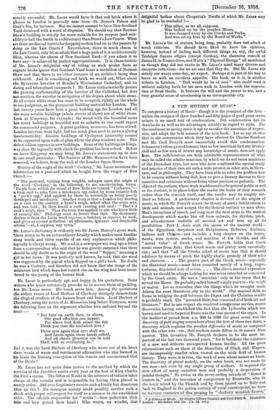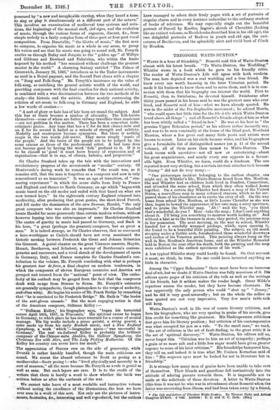A NEW HISTORY OF MIJSIC.*
To compress a history of Music—though it is the youngest of the Arts—. within the compass of three hundred and fifty pages of good print crown octavo is no small feat of condensation. But condensation has its drawbacks as well as its advantages, notably in regard to style. For the condenser in saving space is apt to sacrifice the amenities of expres- sion, and adopt the bald manner of the text-book. Let us say at onto that in the compromise which they have effected Sir Charles Stanford and Mr. Cecil Forsyth most successfully avoid this condemnation. Schumann's often-quoted lament, that so few musicians had any literary skill and so few men of letters any knowledge of music, does not apply here. The collaborators are both admirable representatives of what may be called the scholar-musician, by which we do not mean musicians of the Dryasduat type, but men who have combined the special study and practice of their own art with a wide interest in other arts, in litera- ture, and in philosophy. They have been able to solve the problem how to be concise without being dull, how to give a literary flavour to their narrative and criticisms without being either precious or pedantic. The object of the authors, whose work is addressed to the general public as well
as the student, is to place before the reader the fruits of their r —.arch rather than the research itself, and the results may be roughly out- lined as follows. A preliminary chapter is devoted to the origins of music, in which Mr. Forsyth scouts the theory of man's indebtedness to birds and animals, and assigns the rhythmical instinct to man alone. Man's inventions of speech and song were the next steps in the musical development which marks him off from animals, for rhythm, pitch, and articulateness underlie all musical art and sum up all its possibilities. Part I. deals with the music of the ancient world— of the Egyptians, Assyrians and Babylonians, Hebrews, Arabian?, Indians and Chinese—and includes a long chapter on the instru- ments, tone system, modes, and notation of the Greeks, and the " moral value" of Greek music. Mr. Forsyth holds that Greek music came from Asia; that Greek music and poetry were essentially one ; and that " all the Greeks asked of music was that it should reinforce by means of pitch the highly elastic prosody of their solos and choruses. . . . The greater part of the Greek music—especially the theatrical music—must have consisted merely of a long, vague, tortuous, disjointed sort of arioso. . . . The direct. musical expression which we should be always looking for was never intended or conceived by the Greek artist. He was a ' musician ' only in the sense that he served the Muses. He probably called himself simply poietes—the wield or maker. Let us remember that the things which ho wrought made Athens the most illustrious city in the world." Out musical debt to Rome in bridging the gulf between the Pagan and the Christian worlds is probably small. She "invented little, but commandeered both art and literature." But in one respect she rendered conspicuous service, recent discoveries having established the fact that the hydraulus which was known and used in Luperial Rome was the true parent of the organ. In the mediaeval period from A.D. 900 to 1000 the great event was the discovery of part singing somewhere about the first of these two dates, a discovery which explains the peculiar differentia of music as compared with the other arts—viz., that modern music differs in its essence from ancient. This invention Mr. Forsyth declares to be the most im- portant of the last two thousand years, " for it betokens the existence of a new and hitherto unsuspected human faculty. All the great reformations such as those of the Monodists, of Gluck and Wagner. are incomparably smaller when viewed on the wide field of human history. They were, it is true, the work of men whose names we know. The discovery of plural melody, on the other hand, was not made by one man—not even by any single group of authors. It required the slow effort of many nameless men and probably a desperation of painful thought." To arrive at the never-ending miracle of " Sumer is icemen in," and the invention of composition by Dunstable, who lit the torch seized by the Flemish and by them passed on to Italy and back to England in the golden century of vocal counterpoint, we have to traverse centuries of dins groping by "shadowy monkish figures," • d Ilittory of Music. By Ohartes Vllliers Stanford and Cecil Forsyth• Illustrate. London : Macmillan and Co. (78. Od. net.)
possessed by "a new and inexplicable craving, when they heard a tune, to sing or play it simultaneously at a different part of the octave." This involves an examination of mediaeval tone systems and nota- tions, the beginnings of the musical staff, clef-signs, and the evolution of music, through the various forms of organum, distant, &c., from simple melody to a fairly complex form of three-part or four-part vocal composition. From Dunstable, " the Giotto of music," the first man to compose, to organize his music as a whole in our sense, to group his voices and see that his music was going to sound well, Mr. Forsyth carries us through Dufay and Josquin to the " golden age " of Wilbye and Gibbons and Dowland and Palostrina, who within the limits (unposed by his method "has remained without challenge the greatest master in the world." A charming fantasy entitled " The Palace of Greenwich, January 26, 1595," introduces us to the Tudor instruments as used in a Royal pageant, and the Second Part closes with a chapter on " Bong and Folk-Song." Mx. Forsyth's insistence on the value of folk-song, as enriching the general artistic wealth of the world, and providing composers with the final sanction for their national activity, is combined with a wise discrimination between the two methods of its study—the historic and the artistic. After acutely contrasting the relation of art-music to folk-song in Germany and England, he adds a few words of caution :—
" A sort of glory or halo has of late been set round the subject. And this has at times become a nimbus of obscurity. The folk-lorists themselves—some of whom are better railway-travellers than musicians, —are not guiltless in this matter. There has been a somewhat indis criminate praise. Any tune that has a C for its first climax-note and an E for its second is hailed as a miracle of strength and subtlety. Modality and masterpiece become synonyms. But there is nothing magic in the two words lea-music. They mean simply music of the people.' And the tunes of the people are to be judged by the same canons as those of the professional artist. A bad tune does not become good by having the word folk' prefixed to it. If it is to be classed as good' it must have beauty of expression and of organization—that is to say, of climax, balance, and proportion."
Sir Charles Stanford takes up the tale with the innovations and revolutionary progress of the seventeenth or " secular" century. Of Monteverde's daring work he remarks that " the result was, as it remains still, that the man is forgotten as a composer and now is only remembered as an innovator." It was an age of transition, of " sim- mering experiment " in which the scene shifts from Italy to France and England, and thence to North Germany, an age which "began with music based on the old modes and ended with that based on what are now termed keys." In the eighteenth century England relapsed into mediocrity, after producing that great genius, the short-lived Purcell, and fell under the domination of the carp Sansone, Handel, " the only great composer who was also an impresario." Sir Charles Stanford treats Handel far more generously than certain modern writers, -without however lapsing into the extravagance of some Handel-worshippers. The centre of gravity in music had passed to Germany, and Bach is his hero, " a great (perhaps the greatest) composer, but as great a man." It is indeed strange, as Sir Charles observes, that so convinced a hero-worshipper as Carlyle should have not even mentioned the historic meeting between Frederick the Great and Johann Sebastian the Greatest. A genial chapter on the great Viennese masters, Haydn, Mozart, Beethoven, and Schubert, a survey of Beethoven's contem- poraries and successors, and a vivid sketch of the development of opera in Germany, Italy, and France complete Sir Charles Stanford's con- tribution to the volume, Mr. Forsyth conoluding with what is perhaps his greatest tour de force, a final chapter on modem tendencies, in which the composers of eleven European countries and America are grouped and treated from the " national " point of view. The catho- licity of his outlook may be gauged from the fact that the composers dealt with range from Strauss to Sousa, Mr. Forsyth's estimates are generally sympathetic, though plainspoken to the verge of audacity, and often witty. He begins his notice of Mr. Frank Bridge by remarking that "he is unrelated to Sir Frederick Bridge." Mr. Bath is "the leader of the anti-gloom crusade." But the most engaging notice is that of the American composer, Stillman Kelley
Stillman Kelley,' his biographer says, began his terrestrial career April 14th, 1857, in Wisconsin.' His spiritual career he began in Germany, to which place he has since returned for a course of mental massage. His big works include a piano quintet, a string quartet, a suite made up from his early Macbeth music, and a New England +Symphony, a work which '—biographer again= was successful in ' Germany.' The real nn-kidtured Kelley is probably the brilliant composer of the Chinese suite Aladdin, the Gulliver Symphony, the Christmas Eve with Alice, and The Lady Picking Mulberries. Of this Kelley his country can never have too much.'
The appreciation a Strauss errs on the side of generosity, while Dvorak is rather harshly handled, though the main criticisms are sound. We resent the absurd reference to Scott as posing as a mediaevalist—Scott posing !—who "lived physically and mentally in a sort of museum," all the more because Mr. Forsyth as a rule is genial as well as sane. But such lapses are rare. It is to the credit of the writers that there is hardly a word to show whether the book was -written before or after the outbreak of the war.
We cannot take leave of a most readable and instructive volume -without noting the excellence of the illustrations, the best we have ever seen in a work of this sort. Not only are the pictures of instru- ments, facsimiles, &c., interesting and well reproduced, but the authors have managed to adorn their lively pages with a set of portraits of singular charm and in every instance unfamiliar to the ordinary student of books of reference. We may especially single out the beautiful portrait of Purcell by Kneller, Ingres's sketch of Cherubini (looking like an extinct volcano, as Mendelssohn described him in his old age), the two delightful portraits of Brahma in youth and old age, the cari- catures of Beethoven, and the splendidly alert and vivid, bust of Gluck by Hendon.



































 Previous page
Previous page